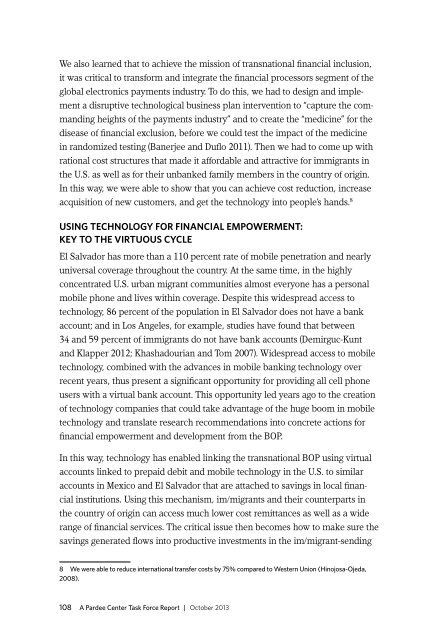Pardee-CFLP-Remittances-TF-Report
Pardee-CFLP-Remittances-TF-Report
Pardee-CFLP-Remittances-TF-Report
You also want an ePaper? Increase the reach of your titles
YUMPU automatically turns print PDFs into web optimized ePapers that Google loves.
We also learned that to achieve the mission of transnational financial inclusion,it was critical to transform and integrate the financial processors segment of theglobal electronics payments industry. To do this, we had to design and implementa disruptive technological business plan intervention to “capture the commandingheights of the payments industry” and to create the “medicine” for thedisease of financial exclusion, before we could test the impact of the medicinein randomized testing (Banerjee and Duflo 2011). Then we had to come up withrational cost structures that made it affordable and attractive for immigrants inthe U.S. as well as for their unbanked family members in the country of origin.In this way, we were able to show that you can achieve cost reduction, increaseacquisition of new customers, and get the technology into people’s hands. 8Using Technology for Financial Empowerment:Key to the Virtuous CycleEl Salvador has more than a 110 percent rate of mobile penetration and nearlyuniversal coverage throughout the country. At the same time, in the highlyconcentrated U.S. urban migrant communities almost everyone has a personalmobile phone and lives within coverage. Despite this widespread access totechnology, 86 percent of the population in El Salvador does not have a bankaccount; and in Los Angeles, for example, studies have found that between34 and 59 percent of immigrants do not have bank accounts (Demirguc-Kuntand Klapper 2012; Khashadourian and Tom 2007). Widespread access to mobiletechnology, combined with the advances in mobile banking technology overrecent years, thus present a significant opportunity for providing all cell phoneusers with a virtual bank account. This opportunity led years ago to the creationof technology companies that could take advantage of the huge boom in mobiletechnology and translate research recommendations into concrete actions forfinancial empowerment and development from the BOP.In this way, technology has enabled linking the transnational BOP using virtualaccounts linked to prepaid debit and mobile technology in the U.S. to similaraccounts in Mexico and El Salvador that are attached to savings in local financialinstitutions. Using this mechanism, im/migrants and their counterparts inthe country of origin can access much lower cost remittances as well as a widerange of financial services. The critical issue then becomes how to make sure thesavings generated flows into productive investments in the im/migrant-sending8 We were able to reduce international transfer costs by 75% compared to Western Union (Hinojosa-Ojeda,2008).108 A <strong>Pardee</strong> Center Task Force <strong>Report</strong> | October 2013


